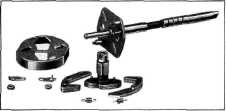1942 - 1947 CHEVROLET SHOP MANUAL
Section 12 - Electrical System
|
|
||||
|
12-25
|
||||
|
|
||||
|
Second, as the engine
is speeded up, centrifugal force
begins to throw the governor weights (inside of the distributor body)
outward, until at a maximum
speed, they reach the point shown in the right-hand sketch of
Fig. 53. In their outward
|
2. Remove
the breaker arm and condenser lead
from the primary terminal and
remove the terminal from
the distributor body.
3. Remove
the other primary terminal and the
screws retaining the breaker
plate in the distributor
body (same screws attach cap springs).
4. Drive
out the pin retaining the distributor gear
on the shaft and remove the
distributor and advance
mechanism assembly from the distributor
body.
5. Remove
the governor weight springs. Bend back
the tangs on the lock plates and
remove the two nuts
holding the advance mechanism cover
and remove the cover.
6. Remove
the cam and governor weights. Wash
all parts in clean gasoline or
cleaning solvent. Figure 55
shows the parts of the advance
mechanism.
|
|||
 |
 |
|||
|
Fig. 53-Mechanical
Breaker Advance Mechanism A-Governor Weight B-Weight Spring Pin
C-Weight Spring
movement, because of the manner in which they
are connected with the cam, they
advance the position of
the cam beyond the point shown in the left-hand sketch of Fig. 53. and
therefore advance the
firing or spark of the engine.
DISTRIBUTOR TESTING
If trouble is suspected with the ignition distributor,
first see if electric current is being delivered
to the distributor by the primary wire from
the switch and battery. If the
distributor is functioning
properly, the primary current will pass
through the breaker arm and
contact points direct from
the coil when the contact points are closed.
To determine whether there is any
trouble at this point,
disconnect the primary wire at the coil and, with the contact points
closed and ignition switch
turned on, strike the terminal end of the wire
against the terminal on the coil.
If there is a spark, the
current is flowing properly. If no spark is
obtained, make the following
examinations: Examine the
spring on the distributor breaker arm.
See that this is not broken and
that it is making a good
contact with the primary terminal.
Examine all primary wires. See that the insulation
is good and that all wires are properly fastened at all points.
Occasionally oil or
grease will get into the distributor
and form a connection between the case and the contact points. Wipe
out thoroughly.
There may be a "ground" in the distributor, due
to defective insulation between
the breaker plate and the
distributor housing.
Examine the contact points to see that they are
clean, not burned or corroded,
and are opening and closing
properly.
DISTRIBUTOR
OVERHAUL Disassembly
1. Remove the lubrication cup, spring and bakelite
shaft contact plug, Fig. 54.
|
||||
 |
||||
|
Fig. 55-Distributor Automatic Advance Mechanism
Inspection
1.
Inspect the shaft for wear, and
check its fit in the
bearings in the distributor body. If the
shaft or bearings are worn, the
shaft and distributor body
should be replaced.
2. Mount
the shaft in "V" blocks and check the
shaft alignment with a dial gauge.
The runout should not
exceed .002".
3. Inspect
the governor weights for wear or burrs and free fit on their pins.
4.
Inspect the cam for wear or
roughness. Then check its fit on the end of the shaft. It should
be absolutely free, without
any looseness.
5.
Inspect the condition of the
distributor points-dirty points should be cleaned and badly pitted
points should be replaced.
6. Test
the condenser for series resistance, microfarad
capacity (.28 to .32) and insulation
breakdown, following the
instructions given by the
manufacturer of the test equipment used.
|
||||
|
|
||||